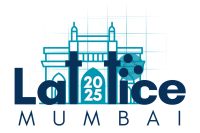Conveners
Quantum computing and quantum information
- Apoorva Patel (Indian Institute of Science, Bangalore, India)
Quantum computing and quantum information
- Emilie Huffman (Wake Forest University)
Quantum computing and quantum information
- Bipasha Chakraborty (University of Southampton)
Quantum computing and quantum information
- Emanuele Mendicelli (University of Liverpool (United Kingdom))
We introduce a novel quantum computational framework for simulating lattice gauge theories by leveraging the advantages of both discrete (qubit) and continuous variables (qumode) quantum computing. The simulations of these hybrid systems can be realized with various quantum hardware platforms like trapped-ion and photonic systems.
By explicitly solving Gauss’s Law at each vertex of the...
The orbifold lattice formulation provides a framework for quantum simulation of lattice gauge theories, enabling the explicit and analytical construction of quantum circuits whose computational cost scales polynomially with the number of qubits. This cost can be further reduced by neglecting selected terms and degrees of freedom in the original formulation, leading to two simplified versions....
We present a qubit-based approach for simulating Quantum Electrodynamics (QED), extending the well-established quantum algorithm for scalar field theory to gauge fields. Our method ensures gauge invariance, which automatically enforces Gauss’s law, and is formulated in the lattice framework akin to Wilson or Kogut-Susskind theory. The qubit representation is designed to align with finite Weyl...
The existence of an approximate spectrum-generating algebra in the PXP model has been extensively studied as a mechanism underlying quantum many-body scars. Since the PXP model can be mapped to a gauge theory in one spatial dimension, a natural question arises: can similar algebraic structures and scar-like dynamics occur in higher-dimensional gauge theories? In this work, we show that this is...
Lattice Hamiltonians with gauge symmetry are characterized by a local symmetry transformation per lattice site and may even exhibit further higher-form symmetries. There are then an exponentially large number of dynamically disconnected symmetry sectors, most of which are not translation-invariant. This results in localized dynamics even without the presence of disorder. An exponential number...
We present a lattice calculation of the parton distribution function (PDF) of the lightest positronium system employing the 1+1D Schwinger model in the Hamiltonian formulation, implemented within a quantum computational framework on an IBM quantum computer. Our setup employs a total of 11 qubits: 10 qubits represent stagger fermions sites, which correspond to five spatial lattice sites and one...
Quantum simulations of fundamental gauge theories require a thorough understanding of non-unitary dynamics that arise from interactions with an environment, including measurements. This talk focuses on the one-dimensional Z₂ gauge theory, a foundational model for probing such effects. Using tensor network calculations, we investigate the dynamics of entanglement entropy when physical...
The quantum imaginary time evolution (QITE) is a quantum algorithm that approximates imaginary-time evolution using unitary operators.
We apply the QITE to the two-dimensional pure $\mathbb{Z}_2$ lattice gauge theory to obtain the ground state energy. In addition, we estimate the algorithmic and statistical errors and computational costs via classical simulation. It was also shown in the...
We study the ground state energy of a two-dimensional pure $\mathbb{Z}_2$ lattice gauge theory (LGT) on a triangular lattice by applying the sample-based quantum Krylov diagonalization. Moreover, an error detection and mitigation method based on Gauss’s law constraints is incorporated. We demonstrate this method in the $\mathbb{Z}_2$ LGT using the IBM quantum hardware and classical tensor...
The Variational Quantum Eigensolver (VQE) is a leading hybrid quantum-classical algorithm for simulating many-body systems in the NISQ era. However, its effectiveness relies not only on accessing ground-state energies but also on preparing accurate eigenvectors, and the later is particularly challenging in degenerate and strongly entangled regimes. We investigate this problem using the...
The Harrow–Hassidim–Lloyd (HHL) algorithm offers an exponential quantum speedup for solving sparse, well-conditioned linear systems of equations. We have implemented the HHL algorithm and evaluated its performance across systems of varying sparsity and recorded each class separately with sizes upto $N=1024$.
The principal bottleneck of HHL lies in Quantum Phase Estimation. To address...
Entanglement calculations in quantum field theories are extremely challenging and typically rely on the replica trick, where the problem is rephrased in a study of defects. We demonstrate that the use of deep generative models drastically outperforms standard Monte Carlo algorithms. Remarkably, such a machine-learning method enables high-precision estimates of Rényi entropies in three...
Accurately simulating long-time dynamics of quantum many-body systems—whether in real or imaginary time—is a challenge in both classical and quantum computing due to the accumulation of Trotter errors. While low-order Trotter-Suzuki decompositions are straightforward to implement, their rapidly growing error limits access to long-time observables and ground state properties. I will present a...
Simulating the real-time dynamics of SU(3) strings is one of the major near-term goals for the quantum simulation community. We propose a protocol for an analog quantum simulation of this non-Abelian physics using cold atoms. Based on the Loop-String-Hadron (LSH) framework, our approach maps the SU(3)-invariant dynamics of strings and hadrons onto an SU(3) ionic Fermi-Hubbard model with three...
We discuss how a systematic partitioning of the terms in a lattice gauge theory Hamiltonian, with regard to electric-basis discretization, can be done so as to dramatically reduce the number of terms to be simulated in product-formula-based quantum simulation protocols (including Trotterization). Compared to another frequently cited proposal, this simple regrouping can immediately drop at...
Quantum simulation of non-Abelian gauge theories like QCD requires an efficient encoding of physical degrees of freedom that respects gauge invariance. The Loop-String-Hadron (LSH) formulation offers a promising path, significantly reducing the number of qubits required to represent the SU(3) invariant states in 1+1 dimensions compared to traditional approaches. While the LSH basis...

